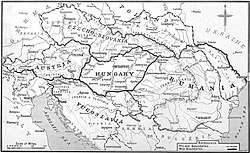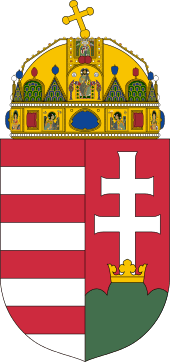First Hungarian Republic
The First Hungarian Republic (Hungarian: Első Magyar Köztársaság),[1] until 21 March 1919 the Hungarian People's Republic (Magyar Népköztársaság), was a short-lived unrecognized people's republic that existed – apart from a 133-day interruption in the form of the Hungarian Soviet Republic – from 16 November 1918 until 8 August 1919. The republic was established in the wake of the dissolution of Austria-Hungary following World War I. The First Hungarian Republic replaced the Kingdom of Hungary, and was in turn replaced by the Hungarian Republic, another short-lived state from 1919 to 1920. During the rule of Count Mihály Károlyi's pacifist cabinet, Hungary lost the control over approximately 75% of its former pre-World War I territories (325,411 km2 (125,642 sq mi)) without armed resistance and was subject to foreign occupation.
Hungarian People's Republic Magyar Népköztársaság | |||||||||||||
|---|---|---|---|---|---|---|---|---|---|---|---|---|---|
| 1918–1919 | |||||||||||||
 Partition of Austria-Hungary: boundaries as defined in the treaties, 1919 | |||||||||||||
| Status | Unrecognized rump state | ||||||||||||
| Capital | Budapest | ||||||||||||
| Official language | Hungarian | ||||||||||||
Common languages | German, Slovak, Croatian, Romanian | ||||||||||||
| Government | People's republic | ||||||||||||
| Regent | |||||||||||||
• 7 August 1919 | Joseph August | ||||||||||||
| President | |||||||||||||
• 16 November 1918 | Mihály Károlyi | ||||||||||||
• 1 August 1919 | Gyula Peidl (acting) | ||||||||||||
| Prime Minister | |||||||||||||
• 31 October 1918 | Mihály Károlyi | ||||||||||||
• 11 January 1919 | Dénes Berinkey | ||||||||||||
• 1 August 1919 | Gyula Peidl | ||||||||||||
• 7 August 1919 | István Friedrich | ||||||||||||
| Legislature | National Council | ||||||||||||
| Historical era | Interwar period | ||||||||||||
| 31 October 1918 | |||||||||||||
• Establishment | 16 November 1918 | ||||||||||||
| 21 March 1919 | |||||||||||||
• Re-establishment | 1 August 1919 | ||||||||||||
• Dissolution | 8 August 1919 | ||||||||||||
| 4 June 1920 | |||||||||||||
| Area | |||||||||||||
• Total | 282,870 km2 (109,220 sq mi)[lower-alpha 1] | ||||||||||||
| Population | |||||||||||||
• 1920 | 7,980,143 | ||||||||||||
| Currency |
| ||||||||||||
| ISO 3166 code | HU | ||||||||||||
| |||||||||||||
| Today part of | Hungary | ||||||||||||
| |||||||||||||
Following this period, the Allied Powers of World War I severely pressured the Hungarians into retreating behind post-war demarcation lines as a provision to the Paris Peace Conference of 1919, their attempt to establish new nation states among the former kingdom's non-Hungarian citizens – the principal beneficiaries of which were the Kingdom of Romania, the Kingdom of Serbs, Croats, and Slovenes, the Austrian Republic, and the Czechoslovak Republic. The subsequent Treaty of Peace between the Allied and Associated Powers and Hungary was signed under protest by the latter.
Name
"Hungarian People's Republic" was adopted as the official name of the country on 16 November 1918,[2][3][4] and remained in use until the overthrow of the Dénes Berinkey government on 21 March 1919. Following the collapse of the Hungarian Soviet Republic, the Gyula Peidl government restored the pre-communist name of the state on 2 August 1919.[5][6]
The government of István Friedrich changed the name to "Hungarian Republic" on 8 August;[7][8][9] however, the denomination "Hungarian People's Republic" appeared on some government-issued decrees during this period.[10][11]
History
Károlyi era
Part of a series on the |
||||||||||||||||||||
|---|---|---|---|---|---|---|---|---|---|---|---|---|---|---|---|---|---|---|---|---|
| History of Hungary | ||||||||||||||||||||
 | ||||||||||||||||||||
|
Early history
|
||||||||||||||||||||
|
Medieval
|
||||||||||||||||||||
|
Early modern
|
||||||||||||||||||||
|
Late modern
|
||||||||||||||||||||
|
Contemporary
|
||||||||||||||||||||
|
| ||||||||||||||||||||
The Hungarian People's Republic was created by the Aster Revolution, which started in Budapest on 31 October 1918. That day, King Charles IV appointed the revolt's leader, Mihály Károlyi, as Hungarian prime minister. Almost his first act was to formally terminate the personal union between Austria and Hungary. On 13 November, Charles issued a proclamation withdrawing from Hungarian politics. A few days later the provisional government proclaimed Hungary a people's republic,[2] with Károlyi as both prime minister and interim president. This event ended 400 years of rule by the House of Habsburg.
The Károlyi government's measures failed to stem popular discontent, especially when the Entente powers began distributing slices of what many considered Hungary's traditional territory to the majority ethnic groups in Kingdom of Romania, the Kingdom of Serbs, Croats and Slovenes, and the First Czechoslovak Republic. The new government and its supporters had pinned their hopes for maintaining Hungary's territorial integrity on the abandonment of Cisleithania and Germany, the securing of a separate peace, and exploiting Károlyi's close connections in the French Third Republic.
The Entente considered Hungary a partner in the defeated Dual Monarchy, and dashed the Hungarians' hopes with the delivery of successive diplomatic notes. Each demanded the surrender of more land to other ethnic groups. On 20 March 1919, the French head of the Entente mission in Budapest gave Károlyi a note delineating the final postwar boundaries, which the Hungarians found unacceptable.[12] Károlyi and Prime Minister Dénes Berinkey were now in an impossible position. They knew accepting the French note would endanger the country's territorial integrity, but were in no position to reject it. In protest, Berinkey resigned.
Károlyi informed the cabinet that only the Hungarian Social Democratic Party could possibly form a new government. Unknown to Károlyi, however, the Social Democrats had merged with the Hungarian Communist Party; the latter promised that the Russian SFSR would help Hungary to restore its original borders. Although the Social Democrats held a majority in the newly merged Hungarian Socialist Party, the communists led by Béla Kun immediately seized control and announced the establishment of the Hungarian Soviet Republic on 21 March 1919.
Re-establishment and dissolution
After the fall of the Soviet Republic on 1 August 1919, a social democratic government—the so-called "trade union government"—came to power under the leadership of Gyula Peidl.[13] A decree was issued on 2 August restoring the form of government and the official state name back to "People's Republic".[5] During its brief existence, the Peidl government began to abrogate the edicts passed by the Communist regime.[14]
On 6 August, István Friedrich, leader of the White House Comrades Association—a right-wing, counter-revolutionary group—seized power in a bloodless coup with the backing of the Royal Romanian Army.[6] The next day, Joseph August declared himself regent of Hungary—he held the position until 23 August, when he was forced to resign[15]—and appointed Friedrich as Prime Minister. The state was formally dissolved by the new government on 8 August 1919.
See also
- Hungary between the World Wars
- Revolutions and interventions in Hungary
- Red Terror in Hungary
- White Terror in Hungary
References
Notes
- Lambert, S. "The First Hungarian Republic". The Orange Files. Retrieved 11 March 2019.
- 1918. évi néphatározat (in Hungarian) – via Wikisource.
- Pölöskei, F.; et al. (1995). Magyarország története, 1918–1990 (in Hungarian). Budapest: Korona Kiadó. p. 17. ISBN 963-8153-55-5.
- Minisztertanácsi jegyzőkönyvek: 1918. november 16 (in Hungarian). DigitArchiv. p. 4.
- A Magyar Népköztársaság Kormányának 1. számu rendelete Magyarország államformája tárgyában (in Hungarian) – via Wikisource.
- Pölöskei, F.; et al. (1995). Magyarország története, 1918–1990 (in Hungarian). Budapest: Korona Kiadó. pp. 32–33. ISBN 963-8153-55-5.
- A Magyar Köztársaság miniszterelnökének 1. számu rendelete a sajtótermékekről (in Hungarian) – via Wikisource.
- 4072/1919. M. E. számú rendelet (in Hungarian) – via Wikisource.
- Raffay, E. (1990). Trianon titkai, avagy hogyan bántak el országunkkal (in Hungarian). Budapest: Tornado Damenia. p. 125. ISBN 963-02-7639-9.
- 3923/1919. M. E. számú rendelet (in Hungarian) – via Wikisource.
- 70762/1919. K. M. számú rendelet (in Hungarian) – via Wikisource.
- Romsics, Ignác (2004). Magyarország története a XX. században (in Hungarian). Budapest: Osiris Kiadó. p. 123. ISBN 963-389-590-1.
- Romsics, I. (2004). Magyarország története a XX. században (in Hungarian). Budapest: Osiris Kiadó. p. 132. ISBN 963-389-590-1.
- Minisztertanácsi jegyzőkönyvek: 1919. augusztus 3 (in Hungarian). DigitArchiv. p. 6.
- "Die amtliche Meldung über den Rücktritt" (in German). Neue Freie Presse, Morgenblatt. 24 August 1919. p. 2.
Bibliography
- Overy, R., ed. (1996). The Times History of the 20th Century. London: Times Books. ISBN 9780723007661.CS1 maint: ref=harv (link)
- Rokai, P.; Đere, Z.; Pal, T.; Kasaš, A. (2002). Istorija Mađara (in Serbian). Belgrade: CLIO. ISBN 9788671020350.CS1 maint: ref=harv (link)
- Siklós, A. (1988). Revolution in Hungary and the Dissolution of the Multinational State, 1918. Budapest: Akadémiai Kiadó. ISBN 9789630544665.CS1 maint: ref=harv (link)
- Tarsoly, I. K., ed. (1995). "Magyarország". Révai nagy lexikona (in Hungarian). Budapest: Babits Kiadó. vol. XX. pp. 595–597. ISBN 9789638318701.CS1 maint: ref=harv (link)
External links

.svg.png)
.svg.png)